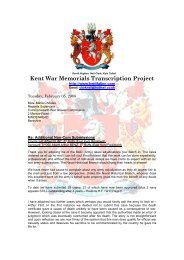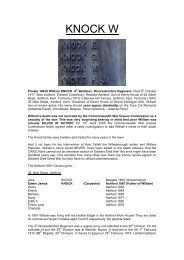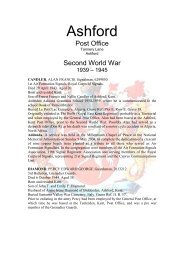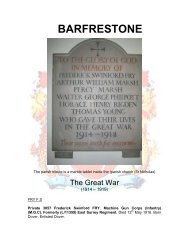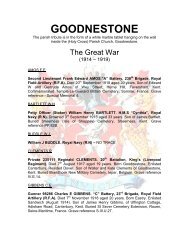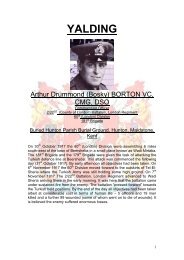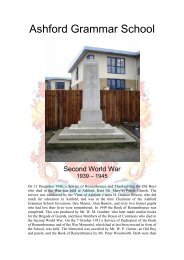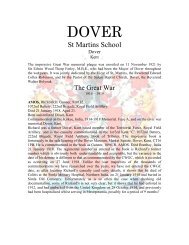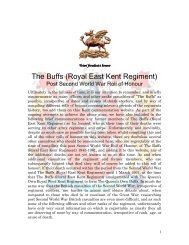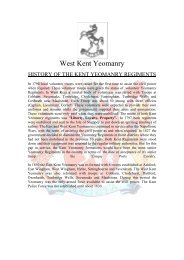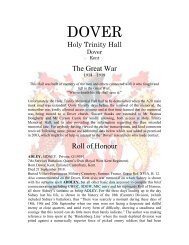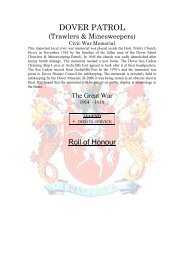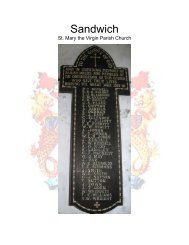GRAVESEND IMPERIAL PAPER MILLS UPDATE - Kent Fallen
GRAVESEND IMPERIAL PAPER MILLS UPDATE - Kent Fallen
GRAVESEND IMPERIAL PAPER MILLS UPDATE - Kent Fallen
Create successful ePaper yourself
Turn your PDF publications into a flip-book with our unique Google optimized e-Paper software.
Gravesend Imperial Paper Mills<br />
1
The Gravesend Imperial Paper Mills Great War memorial plaque is located<br />
at the entrance to the White House, which was formerly the offices of the<br />
Imperial Paper Mills at Imperial Wharf. Gravesend, as can be seen on one of<br />
the accompanying photographs by Rob Bedwell. On the opposite of the<br />
entrance is another plaque which is in rememberance of Alfred Charles<br />
William Harmsworth, 1st Viscount Northcliffe. We are much indebted to Rob<br />
Bedwell for the photographs, and to Patrick D. Scullion for carrying out the<br />
following transcriptions The Great War memorial plaque is inscribed with<br />
the names of fifty four casualties, and bears the following inscription:-<br />
IN PROUD AND GRATEFUL REMEMBERANCE OF THE MEN FROM<br />
THE <strong>IMPERIAL</strong> <strong>PAPER</strong> <strong>MILLS</strong> WHO GAVE THEIR LIVES IN THE<br />
GREAT WAR<br />
The Great War<br />
1914 -1919<br />
AITKEN, Lance Corporal, WILLIAM WHITELEY, G/731.<br />
"C" Company, 7th (Service) Battalion, The Buffs (East <strong>Kent</strong> Regiment).<br />
Died Thursday 3 May 1917. Aged 20.<br />
Born New Mills, Manchester, Lancashire. Enlisted London. Resided Gravesend,<br />
<strong>Kent</strong>.<br />
Son of William Alexander Aitken and Sarah Elizabeth Aitken of Alexander Lodge,<br />
Lennox Road, Gravesend, <strong>Kent</strong>.<br />
Commemorated on the Arras Memorial, Pas de Calais, France. Bay 2, and on<br />
the Gravesend, <strong>Kent</strong> civic war memorial.<br />
When William enlisted in the army on 7 September 1914, he stated that he was<br />
19 years old and employed as a Paper Maker. Following his training and service<br />
in England, William was posted to France on 28 July 1915. With some<br />
justification it is probably fair to say that the various commentators remarks about<br />
the action fought on the 2/3 May 1917 at the village of Chérisy, to the south east<br />
of Arras, France, by the 7th (Service) Battalion, The Buffs (East <strong>Kent</strong> Regiment),<br />
and by the other battalions taking part, along the lines of it being a failure are well<br />
grounded. It should be hastily pointed out however, that non of those<br />
(irrespective of country etcetera) who have passed judgment on same, have ever<br />
leveled any criticisms or disparaging remarks about those who took part in the<br />
action, which was undertaken as part of the overall battles of the Scarpe. On the<br />
night of 2/3 May 1917, William’s battalion was opposite the village of Chérisy,<br />
which is situated only a short distance to the south of the Arras to Cambrai road<br />
(D939). Waiting in readiness for the attack were the officers and other ranks of<br />
both ‘A’ and ‘B’ Companies who had been selected to be the assaulting<br />
companies, with ‘C’ as the supporting Company, and ‘D’ Company being held in<br />
reserve, waiting in shell holes to the rear of the support trench. At 0345 hours the<br />
first two companies set off towards the battalions prime objective allotted the<br />
battalion on the morning of 3 May 1917, it being a location named Keeling<br />
Copse. Fortunately all the battalion were clear of the front trench prior to it, and<br />
2
other locations being bombarded by German artillery. Blame for the confusion<br />
which had prevailed during the attack has been ascertained to numerous causes<br />
and people, but an overriding factor oft referred to was the fact that during the<br />
early stages of the days events, it had been pitch black. As the direct result of the<br />
lack of light, all the sections, platoons and even companies seen got mixed up<br />
and muddled. At one point virtually the whole of the 12th (Territorial Force)<br />
Battalion, Middlesex Regiment, had crossed in front of the 7th (Service)<br />
Battalion, The Buffs (East <strong>Kent</strong> Regiment), but with a measure of commendable<br />
skill that error was corrected. With the coming of dawn the village of Chérisy was<br />
not only reached but actually passed, and as it was entered by the battalion<br />
touch was made with the same Middlesex battalion which had ‘strayed’ across its<br />
front earlier in the attack. Upon reaching the river Sensée beyond Chérisy, it was<br />
noted that the adjacent battalions had in fact lost touch with each other again. As<br />
the result of the set-back, Captain Black of ‘A’ Company wisely halted the<br />
battalion, and set about forming a defensive flank along the road which runs to<br />
the south east of Chérisy. Before the reorganization could be accomplished, the<br />
troops were heavily attacked, which had the additional result of the message sent<br />
back by Captain Black failing to get back. By 0900 hours Captain Black’s<br />
Company on the right flank of the battalion was unable to move. Resulting from<br />
the situation which ‘A’ Company was in, had the effect of those on the opposite<br />
flank losing what advantages it had made, with both ‘B’ and ‘C’ Companies<br />
having by that time also fought their way to the Sensée. Shortly afterwards, fresh<br />
orders were received by the 7th (Service) Battalion, The Buffs (East <strong>Kent</strong><br />
Regiment), to advance in unison with the 8th (Service) Battalion, East Surrey<br />
Regiment to the ‘Red Line,’ and their fellow 55th Brigade, 18th (Eastern) Division,<br />
members of the 7th (Service) Battalion, Queen’s Own (Royal West <strong>Kent</strong><br />
Regiment), to consolidate the ‘Blue Line.’ At approximately 1100 hours unclear<br />
reports filtered through that a general retirement was taking place, at a time when<br />
stretcher bearers and the like were engaged on rescue undertakings. An<br />
unfortunate result of the confusion generated by the ‘retirement’ was that those<br />
engaged on the rescues, those retiring and the enemy soldiers were to all intents<br />
and purposes intermingled, which had the knock on effect of making it virtually<br />
impossible to open fire. After the ‘retirement’ was stopped the attack, albeit with<br />
less momentum got under way again, and as late as 1915 hours an attempt was<br />
made to reoccupy ‘Cable Trench’ by the 7th (Service) Battalion, The Queen’s<br />
(Royal West Surrey Regiment), supported by William’s battalion, but is was to no<br />
avail as the assaulting battalion was driven back by intense German machine<br />
gun and rifle fire. By the end of the day on 3 May 1917, the 7th (Service)<br />
Battalion, The Buffs (East <strong>Kent</strong> Regiment) was back in the original front line<br />
trenches. As the result of the failed attack at Chérisy, the battalion had two<br />
officers killed, six wounded and four missing, and the casualties to the other<br />
ranks were one hundred and twenty killed, one hundred and sixty nine wounded,<br />
and approximately one hundred missing. Initially, William was numbered<br />
amongst the other ranks of his battalion who were posted as ‘Missing,’ but later<br />
for official purposes the Army Council presumed that he had died on 3 May 1917.<br />
3
BENNETT, GEORGE. Private, CH/8200.<br />
Royal Marine Light Infantry. (RMR/B/838). H.M.S. Cressy.<br />
Died 22 September 1914. Aged 42.<br />
Adopted son of Maria Bennett of 18, Newman Road, Perry Street, Northfleet,<br />
Gravesend, <strong>Kent</strong>.<br />
Commemorated on the Chatham Naval Memorial. Panel 7, as shown above, and<br />
on the Gravesend, <strong>Kent</strong> civic war memorial.<br />
Early in the Great War, the Royal Navy maintained a patrol of old Cressy class<br />
armoured cruisers which was called ‘Cruiser Force C,’ in an area of the North<br />
Sea known as the Broad Fourteens. On 16 July 1914 the German submarine U-9<br />
had become the first submarine in history to reload torpedoes whilst still<br />
submerged, and on 22 September 1914 the same submarine under the<br />
command of Kapitänleutnant Otto Weddigen who had commanded the U-9 since<br />
1 August 1914, sighted H.M.S.Cressy, H.M.S.Aboukir and H.M.S.Hogue all<br />
steaming NNE at 10 knots without zigzagging, although the patrols were<br />
supposed to maintain a speed of 12 to13 knots and zigzag, the old cruisers were<br />
unable to maintain that speed, and the zigzagging order was widely ignored<br />
mainly due to the fact that there had been no enemy submarines sighted in that<br />
area of the North Sea at that stage of the war. Otto Weddigen and his crew later<br />
the same day put into practice under wartime conditions what they had perfected<br />
in peacetime, and were able to reload torpedoes beneath the waves. Otto<br />
Weddigen maneuvered the U-9 to attack the three cruisers, and at approximately<br />
0625 hours fired a single torpedo at H.M.S.Aboukir which stuck her on her port<br />
side. H.M.S.Aboukir rapidly suffered heavy flooding and despite counter flooding<br />
developed a 20 degree list and lost engine power. It was soon clear that she was<br />
a lost cause and Captain Drummond ordered her to be abandoned although only<br />
one boat had survived the attack, as the result of which most crew had to jump<br />
into the sea. At first Captain Drummond thought that H.M.S.Aboukir had been<br />
mined and signaled the other two cruisers to close and assist with the rescue of<br />
his crew, but he soon realised that it was a torpedo attack and ordered the other<br />
cruisers away, but too late. As H.M.S.Aboukir rolled over and sank only half an<br />
hour after being attacked, Otto Weddigen fired two torpedoes at H.M.S. Hogue<br />
that hit her amidships and rapidly flooded her engine room. Captain Nicholson of<br />
H.M.S. Hogue had stopped his ship to lower boats to rescue the crew of<br />
H.M.S.Aboukir, thinking that as he was the other side of H.M.S.Aboukir from the<br />
enemy submarine he would be safe. Unfortunately the U-9 had managed to<br />
maneuver around H.M.S.Aboukir and attacked H.M.S.Hogue from a range of<br />
about only 300 yards, and it only took H.M.S.Hogue ten minutes to sink as the U-<br />
9 headed for H.M.S.Cressy, which was commanded by Captain Johnson.<br />
H.M.S.Cressy had also stopped to lower boats but she quickly got underway on<br />
sighting a submarine periscope. At about 0720hours Otto Weddigen fired two<br />
torpedoes, one of which just missed, but the other hit H.M.S.Cressy on her<br />
starboard side. The damage to H.M.S.Cressy was not fatal but the U-9 then<br />
turned round and fired her last torpedo as a coup de grace, which hit<br />
4
H.M.S.Cressy sinking her within a quarter of an hour. Survivors of the disaster<br />
were picked up by several nearby merchant ships including the Dutch vessels<br />
Flora and Titan, and the British trawlers JGC and Corainder, before the Harwich<br />
force of light cruisers and destroyers arrived. Flora returned to Holland with 286<br />
rescued crew who were quickly returned to Britain, even though the neutral<br />
Dutch should have interned them. In all 837 men were rescued but 1459 died,<br />
many of whom were reservists or cadets. On 18 March 1915 the German u-boat<br />
U-29 was rammed and sunk by H.M.S. Dreadnought in the Pentland Firth, all 32<br />
submariners onboard perished including Otto Weddigen who had been in<br />
command since 16 February 1915.<br />
BENNETT, THOMAS ALFRED. Private, 5005.<br />
1st/4th (Territorial Force) Battalion, Queen's Own (Royal West <strong>Kent</strong> Regiment).<br />
Died 28 July 1917.<br />
Born Northfleet, <strong>Kent</strong>. Enlisted Gravesend, <strong>Kent</strong>.<br />
Son of George and Maria Bennett.<br />
Commemorated on the Kirkee 1914-1918 Memorial, India. Face 7, and on the<br />
Gravesend, <strong>Kent</strong> civic war memorial.<br />
BIDDLECOMBE, PERCIVAL. Private, 61608.<br />
24th Battalion, Royal Fusiliers (City of London Regiment), (2nd Sportsman’s).<br />
Died 15 January 1917. Aged 19.<br />
Born Southampton, Hampshire. Enlisted and resided Gravesend, <strong>Kent</strong>.<br />
Son of Mrs. Gertrude Biddlecombe of 17, Bligh Road, Gravesend, <strong>Kent</strong>.<br />
Buried Regina Trench Cemetery, Grandcourt, Somme, France.<br />
Grave Ref: IV. A. 20.<br />
Commemorated on the Gravesend, <strong>Kent</strong> civic war memorial.<br />
Formerly Private, L/10661, The Buffs (East <strong>Kent</strong> Regiment).<br />
BONNER, JAMES GEORGE. Driver, T/20320.<br />
Army Service Corps.<br />
Died 6 December 1916. Aged 33.<br />
Born Tovil Maidstone, <strong>Kent</strong>. Enlisted Maidstone, <strong>Kent</strong>. Resided Northfleet, <strong>Kent</strong>.<br />
Son of Elizabeth Bonner of 93, Farleigh Hill, Tovil Maidstone, <strong>Kent</strong>.<br />
Husband of Nellie Emma Bonner (née Harflett) of 73, Rural Vale, Rosherville,<br />
Northfleet, <strong>Kent</strong>.<br />
Buried Louvencourt Military Cemetery, Somme, France.<br />
Grave Ref: Plot 1. Row E. Grave 4.<br />
Commemorated on the Northfleet, <strong>Kent</strong> civic war memorial, and on the<br />
Rosherville, <strong>Kent</strong> civic war memorial.<br />
When James enlisted in the army as a regular soldier on 12 October 1903, for an<br />
engagement of 3 years with the Colours and 9 years in the reserve, he stated<br />
that he was 19 years and 3 months old, and that he was employed as a Paper<br />
Makers Assistant. In reply to being asked a question if he had a preference<br />
regarding which regiment or corps he served in, James replied the Army Service<br />
Corps. Following his enlistment, James joined the Army Service Corps at<br />
5
Woolwich. On 12 January 1905 having completed 2 years service, James was<br />
awarded a Good Conduct Badge, and on 11 January 1906 he was discharged<br />
from his regular army commitment having completed his 3 years service as a<br />
Driver. At the time of his discharge, James was placed on the Army Reserve with<br />
instructions to report back to Woolwich if he was recalled in the event of a<br />
national emergency. James married Miss Nellie Emma Harflett at Maidstone<br />
Registry Office on 10 August 1907. At the commencement of the Great War<br />
James was recalled, and as instructed he reported back at Woolwich on 6<br />
August 1914 and rejoined the Army Service Corps as a Driver, and of prevailing<br />
operational necessity he was posted to France for service in the British<br />
Expeditionary Force on 17 August 1914.<br />
BOURNE, WILLIAM THOMAS JAMES. Private, G/11816.<br />
8th (Service) Battalion, Queen's Own (Royal West <strong>Kent</strong> Regiment).<br />
Died 17 August 1916.<br />
Born Northfleet, <strong>Kent</strong>. Enlisted Gravesend, <strong>Kent</strong>.<br />
Son of Mrs. Mary Jane Bassant (formerly Bourne) of 209, Dover Road,<br />
Northfleet, <strong>Kent</strong>, and of the late William Thomas Bourne.<br />
Commemorated on the Thiepval Memorial, Somme, France. Pier and Face 11 C,<br />
and on the Northfleet, <strong>Kent</strong> civic war memorial.<br />
When William enlisted in the army ‘For the Duration of the War’ on 30 November<br />
1915, he stated that he was employed as a Labourer, and that he resided at 209,<br />
Dover Road, Northfleet, <strong>Kent</strong>, at which time he was 22 years and 137 days old.<br />
Following his enlistment, William was placed on the army reserve until being<br />
mobilised on 22 January 1916. William’s initial training was carried out whilst<br />
serving in the 9th (Reserve) Battalion, Queen's Own (Royal West <strong>Kent</strong><br />
Regiment). On 18 May 1916, William was posted to France with the 8th (Service)<br />
Battalion, Queen's Own (Royal West <strong>Kent</strong> Regiment).<br />
BRADBROOK, JOSEPH WILLIAM. 2nd Corporal, WR/552550.<br />
Inland Water Transport, Royal Engineers.<br />
Died 11 March 1918. Aged 32.<br />
Enlisted Gravesend, <strong>Kent</strong>.<br />
Husband of Mrs. L. Bradbrook of 42, Cutmore Street, Gravesend, <strong>Kent</strong>.<br />
Buried Basra War Cemetery, Iraq. Grave Ref: I. H. 16.<br />
Commemorated on the Gravesend, <strong>Kent</strong> civic war memorial.<br />
Formerly Sapper, 196938, Royal Engineers.<br />
BRADLEY, WILLIAM HENRY. Private, L/1823.<br />
1st Battalion, Queen's Own (Royal West <strong>Kent</strong> Regiment).<br />
Died 24 August 1914.<br />
Born Stone, Dartford, <strong>Kent</strong>. Enlisted Maidstone, <strong>Kent</strong>. Resided Gravesend, <strong>Kent</strong>.<br />
Buried Hautrage Military Cemetery, Saint-Ghislain, Hainaut, Belgium.<br />
Grave Ref: II. D. 1.<br />
BUTTS, ARTHUR WILLIAM. Private, 10740.<br />
6
1st Battalion, East Surrey Regiment.<br />
Died 23 April 1917.<br />
Born Gravesend, <strong>Kent</strong>. Enlisted Maidstone, <strong>Kent</strong>.<br />
Son of Arthur John Butts and Emma Fanny Butts (née Loft) of Gravesend, <strong>Kent</strong>.<br />
Buried La Chaudiere Military Cemetery, Vimy, Pas de Calais, France.<br />
Grave Ref: VI. C. 4.<br />
Arthur had originally served in the 3rd (Reserve), Battalion, East Surrey<br />
Regiment, prior to being posted to the 1st Battalion, East Surrey Regiment for<br />
service with the British Expeditionary Force in France.<br />
CHAMBERS, HARRY JOHN. Private, 74008.<br />
16th Battalion, Machine Gun Corps (Infantry).<br />
Died 6 May 1918.<br />
Born Maidstone, <strong>Kent</strong>. Enlisted Gravesend, <strong>Kent</strong>.<br />
Son of Eliza Chambers of Holbeck Cottage, Snodland, <strong>Kent</strong>.<br />
Husband of Daisy Verbinia Chambers (née Powell) of 1, Gorham Cottages, High<br />
Street, Snodland, <strong>Kent</strong>. Formerly of 15, Winfield Road, Gravesend, <strong>Kent</strong>.<br />
Buried Outtersteene Communal Cemetery Extension Bailleul, Nord, France.<br />
Grave Ref: II. G. 58.<br />
Harry married Miss Daisy Verbinia Powell at Ryarsh, <strong>Kent</strong> on 15 July 1911. He<br />
stated that he was 24 years, 11 months and 21 days old when he enlisted in the<br />
army on 3 June 1916. At the time of his enlistment, Harry also stated that he was<br />
employed as a Stoker, and that he resided at 15, Winfield Road, Gravesend,<br />
<strong>Kent</strong>. On 18 July 1916, harry was mobilised and attested to serve in the Royal<br />
Fusiliers (City of London Regiment), and on 24 July 1916 he was posted to the<br />
16th (Reserve) Battalion of the regiment. From 11 May 1917, Harry served in<br />
France, Having served in a number of battalions of his regiment, Harry was<br />
transferred to the 8th (Service) Battalion, Royal Dublin Fusiliers on 28 May 1917<br />
as Private, 42445. On 9 March 1918 at his own request, Harry transferred to the<br />
Machine Gun Corps to benefit from the better service rate of pay, and the same<br />
day he was posted to the 16th Battalion, Machine Gun Corps (Infantry) in which<br />
he remained until being killed in action.<br />
CHAPMAN, GEORGE WILLIAM. Private, G/979.<br />
4 Company, 6th (Service) Battalion, Queen's Own (Royal West <strong>Kent</strong> Regiment).<br />
Died 8 October 1915. Aged 19.<br />
Born Higham, Rochester, <strong>Kent</strong>. Enlisted and resided Gravesend, <strong>Kent</strong>.<br />
Son of John Thomas Chapman of 65, Peacock Street, Gravesend, <strong>Kent</strong>, and of<br />
the late Charlotte Chapman.<br />
Commemorated on the Loos Memorial, Pas de Calais, France. Panel 95, and on<br />
the Gravesend, <strong>Kent</strong> civic war memorial.<br />
CLIBBON, WILLIAM GORDON. Private, G/4930.<br />
6th (Service) Battalion, Queen's Own (Royal West <strong>Kent</strong> Regiment).<br />
Died 24 October 1918. Aged 33.<br />
Born Strood, <strong>Kent</strong>.<br />
7
Son of Walter and Rose Clibbon.<br />
Husband of Alice Maud Clibbon (née Baker) of 32, Gordon Road, Strood,<br />
Rochester, <strong>Kent</strong>.<br />
Buried Strood Cemetery, Rochester, <strong>Kent</strong>. Grave Ref: B. 210.<br />
William was posted to France on 3 August 1915.<br />
COLEMAN, F. No clear trace at this time of the casualty, as he is<br />
commemorated on the Gravesend Imperial Paper Mills Great War memorial<br />
plaque. Whilst carrying out the ongoing researches and transcriptions of the<br />
Northfleet, <strong>Kent</strong>, civic war memorial, it was noted that William Coleman who is<br />
the next casualty below had a younger brother Fred Coleman, who might be the<br />
Gravesend Imperial Paper Mills commemorated casualty. It would also seem<br />
likely that the Colman brothers father; Robert Coleman who was a native of<br />
Bristol, Gloucestershire, had also been an Imperial Paper Mills employee.<br />
COLEMAN, WILLIAM. Lance Corporal, G/52827.<br />
24th Battalion, Royal Fusiliers (City of London Regiment).<br />
Died Wednesday 29 September 1918. Aged 29.<br />
Born and resided Northfleet, <strong>Kent</strong>. Enlisted Gravesend, <strong>Kent</strong>.<br />
Son of Robert and Sophia Coleman of 34, Station Street, Northfleet, <strong>Kent</strong>.<br />
Husband of the late Winnie Coleman (née Thomkins).<br />
Buried Beaumetz Crossroads Cemetery, Beaumetz-les-Cambrai, Pas de Calais,<br />
France. Grave Ref: F. 28.<br />
Commemorated on the Northfleet, <strong>Kent</strong> civic war memorial.<br />
Formerly Private, G/24469, Middlesex Regiment. William’s medal index card<br />
entry records that he died of wounds on 29 September 1918.<br />
CUNNINGHAM, THOMAS. Private, T/207252.<br />
7th (Service) Battalion, The Queen’s (Royal West Surrey Regiment).<br />
Died 22 October 1917.<br />
Born Wrotham, Sevenoaks, <strong>Kent</strong>. Enlisted Maidstone, <strong>Kent</strong>. Resided Gravesend,<br />
<strong>Kent</strong>.<br />
Buried No Man’s Cot Cemetery, Boesinghe, West-Vlaanderen, Belgium.<br />
Grave Ref: B. 25.<br />
Formerly Private, 20440, East Surrey Regiment.<br />
DIXON, HENRY WILLIAM. Gunner, 128557.<br />
319th Siege Battery, Royal Garrison Artillery.<br />
Died 6 October 1917. Aged 21.<br />
Born Acton, London. Enlisted and resided Gravesend, <strong>Kent</strong>.<br />
Son of Henry John Dixon of 15, Salisbury Road, Gravesend, <strong>Kent</strong>, and of Emily<br />
Dixon<br />
Buried Klein-Vierstraat British Cemetery, Heuvelland, West-Vlaanderen, Belgium.<br />
Grave Ref: III. F. 14.<br />
Commemorated on the Gravesend, <strong>Kent</strong> civic war memorial.<br />
8
Henry’s mothers maiden name was probably Roberts, and had possibly pre<br />
deceased Henry.<br />
DOWLAND, HERBERT. Private, G/997.<br />
6th (Service) Battalion, Queen's Own (Royal West <strong>Kent</strong> Regiment).<br />
Died 8 March 1916. Aged 21.<br />
Born Ramsgate, Isle of Thanet, <strong>Kent</strong>. Enlisted Gravesend, <strong>Kent</strong>. Resided<br />
Northfleet, <strong>Kent</strong>.<br />
Son of William and Elizabeth Harriett Dowland of 45, Hamerton Road, Northfleet,<br />
<strong>Kent</strong>.<br />
Commemorated on the Loos Memorial, Pas de Calais, France. Panel 95, and on<br />
the Northfleet, <strong>Kent</strong> civic war memorial.<br />
DUCK, EDWARD. Ordinary Seaman, J/16642.<br />
Royal Navy, H.M.S. Pathfinder.<br />
Died Saturday 5 September 1914. Aged 18.<br />
Born Northfleet, Gravesend, <strong>Kent</strong> 4 August 1896.<br />
Son of Henry and Mary Ann Duck (née Taylor) of 39, Cecil Road, Gravesend,<br />
<strong>Kent</strong>.<br />
Commemorated on the Chatham Naval Memorial. Panel 3 as shown above, and<br />
on the Gravesend, <strong>Kent</strong> civic war memorial.<br />
H.M.S. Pathfinder a 2,900 ton Pathfinder Scout Class cruiser which was built by<br />
Cammell Laird & Co Ltd at Birkenhead, she was launched on 16 July 1904 and<br />
commissioned on 18 July 1905. At the time of the commencement of the Great<br />
War H.M.S. Pathfinder was the leader of the 8th Destroyed Flotilla based at<br />
Rosyth, Scotland. On Saturday 5 September 1914 whilst running short of coal,<br />
H.M.S. Pathfinder was only making 5 knots at the time of her loss, which was at<br />
approximately 1630 hours when she was torpedoed and sunk in the North Sea<br />
off St. Abbs Head, Berwickshire, Scotland, approximately 10 miles to the<br />
southwest of the Island of May. She was sunk by a torpedo fired from quite long<br />
range from the type U19 Mittel-U class, German u-boat U-21, which at the time<br />
was commanded by Leutnant zur See, Otto Hersing. H.M.S. Pathfinder has the<br />
unenviable distinction of being the first Royal Navy warship to be sunk during the<br />
Great War by a submarine of the Imperial German Navy, and the first ship ever<br />
to be sunk by the use of a torpedo alone fired from a submarine. H.M.S.<br />
Pathfinder was struck by the torpedo in one of her magazines, which exploded<br />
causing the ship to sink within about four minutes with the loss of 259 officers<br />
and ratings; there were only 11 survivors of the sinking. Having sunk 36 ships for<br />
a total of 78,712 tons (warships excluded), on 22 February 1919 the U-21 sunk<br />
as the result of an accident whilst on passage under tow to surrender to the allied<br />
powers. Some data accessed states that the Commander of the U-21 ordered his<br />
crew to open the sea cocks of the u-boat, and scuttled the submarine. Having<br />
later been promoted to Kapitänleutnant, Otto Hersing survived the Great War,<br />
despite having had a not insignificant monetary bounty placed on him by the<br />
9
British. When being interviewed by the journalist Lowell Thomas during the inter<br />
war years, as to what he did for a living, Otto Hersing told him that he was a<br />
Potato Farmer, which took the journalist by surprise as he was expecting him to<br />
answer with something of a nautical bent. Contained within the excellent u-boat<br />
museum at Cuxhaven-Altenbruch, Germany, is a lot of ephemera appertaining to<br />
Otto Hersing, including his Log Book, which notes in detail the events leading up<br />
to the loss of H.M.S. Pathfinder, part of which describes the weather that<br />
prevailed at the time: - “For a terrible time, snow storms and fog, reason why as<br />
soon as we could see nothing, only black cloud strips twisting in grotesques<br />
forms in front of us. But we had to cross the British lines protected by the fog.”<br />
ELLIOTT, JOSEPH JOHN. Corporal, TF/615449.<br />
57th Company, Labour Corps.<br />
Died 16 October 1918.<br />
Born Walworth, Surrey. Enlisted Gravesend, <strong>Kent</strong>. Resided Northfleet, <strong>Kent</strong>.<br />
Buried Romeries Communal Cemetery Extension, Nord, France.<br />
Grave Ref: II. E. 17.<br />
Formerly Corporal, TF/2680, 2nd/1st <strong>Kent</strong> Cyclist Battalion, Army Cyclist Corps.<br />
EVES, E. No clear trace at this time of the casualty, as he is commemorated on<br />
the Gravesend Imperial Paper Mills Great War memorial plaque. Whilst carrying<br />
out the ongoing researches and transcriptions of the Gravesend civic war<br />
memorial, it was noted that Sidney Thomas Eves who fell on Thursday 23<br />
November 1916, had a brother Ernest Eves who might be the Gravesend<br />
Imperial Paper Mills commemorated casualty.<br />
FAIRALL, SIDNEY. Sergeant, 7285.<br />
12th Company, Machine Gun Corps (Infantry).<br />
Died 10 October 1917.<br />
Born Ilford, Essex. Enlisted Gravesend, <strong>Kent</strong>. Resided Northfleet, <strong>Kent</strong>.<br />
Son of Frank and Flora Fairall.<br />
Commemorated on the Tyne Cot Memorial, Zonnebeke, West-Vlaanderen,<br />
Belgium. Panel 154, and on the Northfleet, <strong>Kent</strong> civic war memorial.<br />
Formerly Private, G/10105, Queen's Own (Royal West <strong>Kent</strong> Regiment). Sidney’s<br />
father who was a native of Wandsworth, Surrey, had also been employed as a<br />
Paper Maker at the Gravesend Imperial Paper Mills. On some which was<br />
accessed data accessed, Sidney is shown with his Christian name spelt Sydney.<br />
FARROW, SYDNEY ARTHUR. Gunner, 121716.<br />
462nd Battery, 179th Brigade, Royal Field Artillery.<br />
Born and enlisted Gravesend, <strong>Kent</strong>.<br />
Buried St. Sever Cemetery Extension, Rouen, Seine-Maritime, France.<br />
Grave Ref: P. V. H. 12A.<br />
Commemorated on the Gravesend, <strong>Kent</strong> civic war memorial, and on the<br />
Northfleet, <strong>Kent</strong> civic war memorial.<br />
10
FIELDER, HARRY. Gunner, 120146.<br />
53rd Anti-Aircraft Company, Royal Garrison Artillery.<br />
Died Tuesday 19 November 1918. Aged 27.<br />
Son of Harry and Alice Bullock of Perry Street, Northfleet, <strong>Kent</strong>.<br />
Husband of M. Wise (formerly Fielder) of 38, Cooper Road, Perry Street,<br />
Northfleet, Gravesend, <strong>Kent</strong>.<br />
Buried Gravesend Cemetery, <strong>Kent</strong>. Ref: Screen Wall Commemoration 5297.<br />
The majority of the 82 Great War graves at Gravesend Cemetery are in a special<br />
plot on the south-eastern boundary. The names of those buried in the plot are<br />
recorded on a screen wall. The other Great War burials are scattered throughout<br />
the cemetery.<br />
FINCH, HORACE ARTHUR. Rifleman, A/201474.<br />
9th (Service) Battalion, King's Royal Rifle Corps.<br />
Died 22 October 1917. Aged 27.<br />
Born Gravesend, <strong>Kent</strong>. Enlisted Deptford, <strong>Kent</strong>.<br />
Son of Frederick S. and Amelia C. Finch of Gravesend, <strong>Kent</strong>.<br />
Husband of Louisa Finch of 15, Prospect Place, Gravesend, <strong>Kent</strong>.<br />
Commemorated on the Tyne Cot Memorial, Zonnebeke, West-Vlaanderen,<br />
Belgium. Panel 116.<br />
Formerly Private, TR/13/71339, 111th Training Reserve Battalion. It was noted<br />
whilst carrying out the ongoing researching and transcribing of the Gravesend,<br />
<strong>Kent</strong> civic war memorial, that two Gravesend Great War casualties with the<br />
surname Finch are commemorated on it, but that Horace is numbered amongst<br />
those from the town who are missing from the impressive memorial.<br />
FOTHERGILL, JAMES WILLIAM. Gunner, 46378.<br />
16th Heavy Battery, Royal Garrison Artillery.<br />
Died 25 June 1916. Aged 18.<br />
Born and enlisted Gravesend, <strong>Kent</strong>.<br />
Son of James and Elenor Fothergill.<br />
Nephew of Mr. and Mrs. Windham F. Sandeman of Meadowlands, Longfield,<br />
Gravesend, <strong>Kent</strong>.<br />
Buried Sucrerie Military Cemetery, Colincamps, Somme, France.<br />
Grave Ref: I. F. 21.<br />
Commemorated on the Gravesend, <strong>Kent</strong> civic war memorial.<br />
GOODA, LOUIS FREDERICK. Private, 67234.<br />
Royal Fusiliers (City of London Regiment), posted to the 2nd/2nd (City of London<br />
Battalion), London Regiment (Royal Fusiliers).<br />
Died 26 October 1917.<br />
Born and resided Northfleet, <strong>Kent</strong>. Enlisted Gravesend, <strong>Kent</strong>.<br />
Son of Thomas William Gooda and Victoria Gooda (née Cattee) of Northfleet,<br />
<strong>Kent</strong>.<br />
Commemorated on the Tyne Cot Memorial, Zonnebeke, West-Vlaanderen,<br />
Belgium. Panel 29.<br />
11
Formerly Private, 17827, 29th Training Reserve Battalion. Louis was a brother of<br />
the next casualty briefly commemorated below.<br />
GOODA, THOMAS JAMES. Sapper, 208137.<br />
Inland Water Transport, Inland Water Transport.<br />
Died 21 May 1917.<br />
Born and resided Northfleet, <strong>Kent</strong>. Enlisted Gravesend, <strong>Kent</strong>.<br />
Son of Thomas William Gooda and Victoria Gooda (née Cattee) of Northfleet,<br />
<strong>Kent</strong>.<br />
Buried Basra War Cemetery, Iraq. Grave Ref: IV. N. 17.<br />
GOUGE, ALBERT, Able Seaman, London Z/1697.<br />
Royal Naval Volunteer Reserve. Hawke Battalion, 63rd (Royal Naval) Division.<br />
Died 13 November 1916. Aged 19.<br />
Born Northfleet, <strong>Kent</strong> 3 August 1897.<br />
Son of William James Gouge and Marion Gouge (née Whitbread) of 76,<br />
Springhead Road, Northfleet, <strong>Kent</strong>.<br />
Commemorated on the Thiepval Memorial, Somme, France. Pier and Face 1 A,<br />
and on the Northfleet, <strong>Kent</strong> civic war memorial.<br />
When Albert enlisted as a member of the Royal Naval Volunteer Reserve on 6<br />
May 1915, he stated that he was employed as a Paper Maker and that he<br />
resided with his parents at 76, Springhead Road, Northfleet, <strong>Kent</strong>, and named his<br />
father as his next-of-kin. Albert was amongst a draft of the Mediterranean<br />
Expeditionary Force posted on 9 September 1915, and joined the Hawke<br />
Battalion, 63rd (Royal Naval) Division. From 21 September 1915 to 19 October<br />
1915 Albert was suffering with Dysentery, he later joined the Base Depot at<br />
Mudros on 1 April 1916, joining the Hood Battalion of his division on 13 June<br />
1916. Albert rejoined the Hawke Battalion on 31 July 1916, in which he then<br />
continued to serve until his death, at which time he was posted as Missing,<br />
assumed killed in action. Possibly Albert and Ernest Gouge who is the next<br />
casualty briefly commemorated, were related to Northfleet, <strong>Kent</strong> native Sir Arthur<br />
Gouge B.Sc., M.I.Mech.E., F.I.A.S. (1890-1962). Sir Arthur spent a total of 28<br />
years with Shorts, during which time he was involved in the design and<br />
production of the Empress and Sunderland flying boats and the Stirling bomber.<br />
GOUGE, ERNEST. Rifleman, O/80.<br />
11th (Service) Battalion, Rifle Brigade.<br />
Died Friday 12 April 1918. Aged 19.<br />
Born Shorne, Gravesend, <strong>Kent</strong>. Enlisted Gravesend, <strong>Kent</strong>. Resided Northfleet,<br />
<strong>Kent</strong>.<br />
Son of George and Rose Gouge of 31, All Saints Road, Perry Street, Gravesend,<br />
<strong>Kent</strong>.<br />
Buried St. Sever Cemetery Extension, Rouen, Seine-Maritime, France.<br />
Grave Ref: P. VII. K. 10A.<br />
Commemorated on the Northfleet, <strong>Kent</strong> civic war memorial.<br />
Formerly Private, 10/2771, Training Reserve.<br />
12
GRIFFIN, JOHN. Private, 49491.<br />
12th (Service) Battalion, King’s Own Yorkshire Light Infantry.<br />
Died 13 April 1918. Aged 23.<br />
Born Bradninch, Exeter, Devon. Enlisted Gravesend, <strong>Kent</strong>.<br />
Son of John Griffin and of Agnes Griffin (née Lowman) of 56, Salisbury Road,<br />
Gravesend, <strong>Kent</strong>.<br />
Buried Outtersteene Communal Cemetery Extension Bailleul, Nord, France.<br />
Grave Ref: II. E. 45.<br />
Formerly Private, 54200, Royal Engineers.<br />
HADLER, GEORGE WILLIAM. Private, G/12385.<br />
1st Battalion, Queen's Own (Royal West <strong>Kent</strong> Regiment).<br />
Died 6 September 1916. Aged 31.<br />
Born Tovil, Maidstone, <strong>Kent</strong>. Enlisted Gravesend, <strong>Kent</strong>. Resided Northfleet, <strong>Kent</strong>.<br />
Son of George and Sarah Hadler of 26, Burley Road, Sittingbourne, <strong>Kent</strong>.<br />
Buried Delville Wood Cemetery, Longueval, Somme, France.<br />
Grave Ref: III. N. 10.<br />
HALL, PERCY JOHN. Private, 51198.<br />
"C" Company, 4th Battalion, Bedfordshire Regiment.<br />
Died 25 May 1918. Aged 19.<br />
Born and resided Rosherville, Northfleet, <strong>Kent</strong>. Enlisted Maidstone, <strong>Kent</strong>.<br />
Son of William and Alice Mary Hall of 62, Gordon Road, Rosherville, Northfleet,<br />
<strong>Kent</strong>.<br />
Buried Mesnil Communal Cemetery Extension, Somme, France.<br />
Grave Ref: I. B. 38.<br />
Commemorated on the Northfleet, <strong>Kent</strong> civic war memorial, and on the<br />
Rosherville, <strong>Kent</strong> civic war memorial.<br />
HARDY, CHARLES R. Stoker 1st Class, K/33380.<br />
Royal Navy, H.M.S. Lookout.<br />
Died 9 May 1919. Aged 21.<br />
Born Deptford, <strong>Kent</strong> 7 January 1898.<br />
Buried Greenwich Cemetery, London. Ref: Screen Wall. 1 "C." B. 1217.<br />
Commemorated on the Northfleet, <strong>Kent</strong> civic war memorial.<br />
Greenwich Cemetery where Charles is at rest contains 556 Great War burials.<br />
More than half of these graves are scattered throughout the cemetery, but 263<br />
form a large war graves plot known as ‘Heroes Corner.’ Here, two curved screen<br />
walls bear the names of casualties buried both in the above plot, and in<br />
unmarked graves in the cemetery.<br />
HAYNES, E. No clear trace at this time.<br />
13
HULFORD, E. Only one matching Great War casualty is commemorated by the<br />
Commonwealth War Graves Commission, no data linking him to the Gravesend<br />
Imperial Paper Mills at any time, was found whilst researching the memorial:-<br />
HULFORD, EDWARD. Lance Corporal, 530715.<br />
2nd/15th (County of London) Battalion, London Regiment (Prince of Wales' Own<br />
Civil Service Rifles).<br />
Died 31 October 1917. Aged 24.<br />
Born Wood Green, Middlesex. Enlisted London. Resided Palmers Green,<br />
London.<br />
Son of Fred and Jane Elizabeth Hulford of 74, Shrewsbury Road, New<br />
Southgate, London.<br />
Buried Beersheba War Cemetery, Israel. Grave Ref: N. 26.<br />
KIRBY, HENRY JOHN. Stoker 1st Class, SS/103966.<br />
Royal Navy, (RFR/CH/B/8167). H.M.S. Hogue.<br />
Died 22 September 1914. Aged 27.<br />
Born Gravesend, <strong>Kent</strong> 22 December 1887.<br />
Son of Mrs. M. A. Kirby of 3, Primrose Terrace, South Hill Road, Gravesend,<br />
<strong>Kent</strong>.<br />
Commemorated on the Chatham Naval Memorial. Panel 5 as shown above, and<br />
on the Gravesend, <strong>Kent</strong> civic war memorial.<br />
Early in the Great War the Royal Navy maintained a patrol of old Cressy class<br />
armoured cruisers which was called ‘Cruiser Force C,’ in an area of the North<br />
Sea known as the Broad Fourteens. On 16 July 1914 the German submarine U-9<br />
had become the first submarine in history to reload torpedoes whilst still<br />
submerged, and on 22 September 1914 the same submarine under the<br />
command of Kapitänleutnant Otto Weddigen who had commanded the U-9 since<br />
1 August 1914, sighted H.M.S.Cressy, H.M.S.Aboukir and H.M.S.Hogue all<br />
steaming NNE at 10 knots without zigzagging, although the patrols were<br />
supposed to maintain a speed of 12 to13 knots and zigzag, the old cruisers were<br />
unable to maintain that speed, and the zigzagging order was widely ignored<br />
mainly due to the fact that there had been no enemy submarines sighted in that<br />
area of the North Sea at that stage of the war. Otto Weddigen and his crew later<br />
the same day put into practice under wartime conditions what they had perfected<br />
in peacetime, and were able to reload torpedoes beneath the waves. Otto<br />
Weddigen maneuvered the U-9 to attack the three cruisers, and at approximately<br />
0625 hours fired a single torpedo at H.M.S.Aboukir which stuck her on her port<br />
side. H.M.S.Aboukir rapidly suffered heavy flooding and despite counter flooding<br />
developed a 20 degree list and lost engine power. It was soon clear that she was<br />
a lost cause and Captain Drummond ordered her to be abandoned although only<br />
one boat had survived the attack, as the result of which most crew had to jump<br />
into the sea. At first Captain Drummond thought that H.M.S.Aboukir had been<br />
mined and signaled the other two cruisers to close and assist with the rescue of<br />
his crew, but he soon realised that it was a torpedo attack and ordered the other<br />
14
cruisers away, but too late. As H.M.S.Aboukir rolled over and sank only half an<br />
hour after being attacked, Otto Weddigen fired two torpedoes at H.M.S. Hogue<br />
that hit her amidships and rapidly flooded her engine room. Captain Nicholson of<br />
H.M.S. Hogue had stopped his ship to lower boats to rescue the crew of<br />
H.M.S.Aboukir, thinking that as he was the other side of H.M.S.Aboukir from the<br />
enemy submarine he would be safe. Unfortunately the U-9 had managed to<br />
maneuver around H.M.S.Aboukir and attacked H.M.S.Hogue from a range of<br />
about only 300 yards, and it only took H.M.S.Hogue ten minutes to sink as the U-<br />
9 headed for H.M.S.Cressy, which was commanded by Captain Johnson.<br />
H.M.S.Cressy had also stopped to lower boats but she quickly got underway on<br />
sighting a submarine periscope. At about 0720hours Otto Weddigen fired two<br />
torpedoes, one of which just missed, but the other hit H.M.S.Cressy on her<br />
starboard side. The damage to H.M.S.Cressy was not fatal but the U-9 then<br />
turned round and fired her last torpedo as a coup de grace, which hit<br />
H.M.S.Cressy sinking her within a quarter of an hour. Survivors of the disaster<br />
were picked up by several nearby merchant ships including the Dutch vessels<br />
Flora and Titan, and the British trawlers JGC and Corainder, before the Harwich<br />
force of light cruisers and destroyers arrived. Flora returned to Holland with 286<br />
rescued crew who were quickly returned to Britain, even though the neutral<br />
Dutch should have interned them. In all 837 men were rescued but 1459 died,<br />
many of whom were reservists or cadets. On 18 March 1915 the German u-boat<br />
U-29 was rammed and sunk by H.M.S. Dreadnought in the Pentland Firth, all 32<br />
submariners onboard perished including Otto Weddigen who had been in<br />
command since 16 February 1915.<br />
LANG, JAMES. Gunner, 128514.<br />
310th Siege Battery, Royal Garrison Artillery.<br />
Died 29 July 1917.<br />
Enlisted Gravesend, <strong>Kent</strong>.<br />
Buried Boston Cemetery, Lincolnshire. Grave Ref: T. 933.<br />
Commemorated on the Gravesend, <strong>Kent</strong> civic war memorial.<br />
Formerly Gunner, 993, No. 1 Company (<strong>Kent</strong>), Royal Garrison Artillery.<br />
<strong>MILLS</strong>, HARVEY JAMES. Private, G/11053.<br />
10th (Service) Battalion, Queen's Own (Royal West <strong>Kent</strong> Regiment), (<strong>Kent</strong><br />
County).<br />
Died 7 May 1917. Aged 22.<br />
Born Godstone, Surrey. Enlisted Gravesend, <strong>Kent</strong>. Resided Northfleet, <strong>Kent</strong>.<br />
Son of George and Christina Mills of "Grasmere," Park Avenue, Northfleet,<br />
Gravesend, <strong>Kent</strong>.<br />
Buried Dickebusch New Military Cemetery, Dikkebus, Ieper, West-Vlaanderen,<br />
Belgium. Grave Ref: BB. 18.<br />
Commemorated on the Northfleet, <strong>Kent</strong> civic war memorial.<br />
James was 21 years and 167 days old when he enlisted in the army ‘For the<br />
Duration of the War,’ on 15 November 1915, at which time he stated that he was<br />
employed as a Paper Maker. On 3 May 1916, James sailed from Southampton<br />
15
for service in the British Expeditionary Force, and arrived at the French port of<br />
Harve the following day.<br />
PARROTT, HENRY JAMES. Able Seaman, London/Z/2135.<br />
Royal Naval Volunteer Reserve. H.M.S. Natal.<br />
Died 30 December 1915. Aged 20.<br />
Son of Mary Anne Parrott of 25, The Shore, Northfleet, <strong>Kent</strong>.<br />
Commemorated on the Chatham Naval Memorial. Panel 15 as shown above,<br />
and on the Gravesend, <strong>Kent</strong> civic war memorial, also on the Northfleet, <strong>Kent</strong> civic<br />
war memorial.<br />
H.M.S. Natal was a Royal Navy 13,550 ton Warrior class armoured cruiser which<br />
was commissioned in 1907. She was at anchor in the Cromarty Firth when she<br />
quite literally exploded at about 1520 hours on the afternoon of 30 December<br />
1915. A series of violent internal explosions tore through the ship, and within five<br />
minutes she capsized a blazing wreck. At the time of her loss, the ships<br />
commander Captain, Eric P.C. Back R.N., and his wife were hosting a party<br />
onboard the ship, which included nurses, civilians and children, all of whom were<br />
among the 388 who lost their lives when the ship blew-up. Those bodies which<br />
were recovered from the sea were interred in Rosskeen Churchyard Extensions,<br />
(or Burial Ground) Invergordon, Ross-shire, Scotland, and are included amongst<br />
the 150 Commonwealth burials from both world wars at rest at Rosskeen.<br />
Following the loss of H.M.S. Natal an Admiralty Board of Enquiry was convened;<br />
the official result from same was that the explosion onboard H.M.S. Natal was<br />
due to the deterioration of cordite in the ships magazine. For many years<br />
following the tragedy there was a story circulating in many quarters about the<br />
ship having been sabotaged. This apparently was based on ‘the fact’ that the<br />
Dreadnought battleship H.M.S. Vanguard had also exploded mysteriously after<br />
being visited by a particular Ordnance Chargehand, who also went into the<br />
magazine of H.M.S. Natal just before she too exploded and sank. The man in<br />
question is reputed to have then disappeared without trace; an obvious<br />
explanation accounting for his disappearance was that he too was lost when<br />
H.M.S. Natal exploded. For comprehensive details about the ship, probably the<br />
best book to consult is “They Called It Accident” by A. Cecil Hampshire which<br />
tells the story of H.M.S Natal from when she was launched until her tragic loss.<br />
PENNELL, CHARLES. Private, G/13088.<br />
"C" Company, 7th Battalion, Royal Sussex Regiment.<br />
Died 7 May 1917. Aged 40.<br />
Born Swanscombe, Greenhithe, <strong>Kent</strong>. Enlisted Gravesend, <strong>Kent</strong>.<br />
Son of George Pennell of Swanscombe, Greenhithe, <strong>Kent</strong>.<br />
Husband of Alice Maud Pennell of "Haywood," St. James's Avenue, Gravesend,<br />
<strong>Kent</strong>.<br />
Buried Faubourg-d'Amiens Cemetery, Arras, Pas de Calais, France.<br />
Grave Ref: V. D. 25.<br />
16
Commemorated on the Gravesend, <strong>Kent</strong> civic war memorial.<br />
PENNY, F. No clear trace at this time. Appears to be the casualty who is<br />
commemorated on the Northfleet, <strong>Kent</strong> civic war memorial as F. PENNEY.<br />
REEVES, JOHN WILLIAM. Stoker 2nd Class, K/38155.<br />
Royal Navy, H.M.S. Vanguard.<br />
Died 9 July 1917. Aged 25.<br />
Born Gravesend, <strong>Kent</strong> 25 April 1890.<br />
Husband of Rosina Reeves of 7, William Street, Gravesend, <strong>Kent</strong>.<br />
Commemorated on the Chatham Naval Memorial. Panel 24, and on the<br />
Gravesend, <strong>Kent</strong> civic war memorial.<br />
A survivor from the Battle of Jutland in which she was part of the Forth Battle<br />
Squadron, H.M.S. Vanguard, a 19,560 ton St.Vincent class battleship<br />
commanded by Lieutenant Commander Alan C.H. Duke R.N, blew up and sank<br />
to the north of the Golta peninsula in Flotta, Scapa Flow at approximately 2320<br />
hours on Monday 9 July 1917 with the loss of 843 lives. She went down as the<br />
result of a magazine explosion in one of the two magazines which served the ‘P’<br />
and ‘Q’ turrets amidships. Following her loss an Admiralty Court of Enquiry was<br />
convened, with three possible causes tendered, they being: - (1) A spontaneous<br />
detonation of cordite, which had become unstable. (2) The cordite having caught<br />
fire from heating in an adjacent compartment. (3) Sabotage. To their credit Brian<br />
Budge from Kirkwall, and fellow enthusiast, Jonathan Saunders from Gillingham,<br />
<strong>Kent</strong> have carried out extensive research over a number of years into the loss of<br />
Robert’s ship, and it as the result of their findings that the actual death toll and<br />
following information has been ascertained. The vast majority of those lost with<br />
H.M.S. Vanguard numbering 622, are commemorated on the Chatham Naval<br />
Memorial. Although no formal cause for the cordite explosion was ever found by<br />
the Court of Inquiry, the most likely explanation is that a fire in a coal bunker or<br />
other neighbouring area simply smoldered away undetected long enough to heat<br />
the cordite stored at an adjoining bulkhead to dangerous levels, which eventually<br />
triggered an explosive reaction. Although dwarfed by the losses such as the S.S.<br />
Lancastria off the coast of France in the Second World War, the loss of H.M.S.<br />
Vanguard remains Britain’s worst disaster in Home Waters. The wreck-site of the<br />
ship is now thankfully designated as a controlled site under the Protection of<br />
Military Remains Act.<br />
RESTELL, SYDNEY. Private, 94368.<br />
12th (Service) Battalion, (Pioneers) Sherwood Foresters (Nottinghamshire and<br />
Derbyshire Regiment).<br />
Died 21 March 1918. Aged 19.<br />
Born and resided Northfleet, <strong>Kent</strong>. Enlisted Gravesend, <strong>Kent</strong>.<br />
Son of Eliza Anne Restell of 5, Hartfield Place, Northfleet, <strong>Kent</strong>, and the late<br />
Thomas Restell.<br />
17
Commemorated on the Pozières Memorial, Somme, France. Panel 53, and on<br />
the Northfleet, <strong>Kent</strong> civic war memorial.<br />
Formerly Pioneer, 1290, Royal Engineers.<br />
RING, G. No clear trace at this time.<br />
ROBINSON, WILLIAM FRANCIS. Lance Corporal, G/24471.<br />
23rd (Service) Battalion, Middlesex Regiment, (2nd Football).<br />
Died 30 September 1918. Aged 30.<br />
Born Curragh Camp, County Kildare, Ireland. Enlisted Gravesend, <strong>Kent</strong>. Resided<br />
Northfleet, <strong>Kent</strong>.<br />
Son of John Robinson of 2, Galley Hill Terrace, Swanscombe, <strong>Kent</strong>.<br />
Commemorated on the Tyne Cot Memorial, Zonnebeke, West-Vlaanderen,<br />
Belgium. Panel 114, and on the Northfleet, <strong>Kent</strong> civic war memorial.<br />
RUSSELL, ARTHUR. Stoker 2nd Class, K/38141.<br />
Royal Navy, H.M.S. Vanguard.<br />
Died 9 July 1917. Aged 27.<br />
Born Swanscombe <strong>Kent</strong> 29 March 1890.<br />
Son of Edward Thomas and Rosina Elizabeth Russell.<br />
Husband of Annie Beatrice Russell of 1, Stanbrook Road, Northfleet, <strong>Kent</strong>.<br />
Commemorated on the Chatham Naval Memorial. Panel 24 as shown above,<br />
and on the Gravesend, <strong>Kent</strong> civic war memorial, also on the Northfleet, <strong>Kent</strong> civic<br />
war memorial.<br />
A survivor from the Battle of Jutland in which she was part of the Forth Battle<br />
Squadron, H.M.S. Vanguard, a 19,560 ton St.Vincent class battleship<br />
commanded by Lieutenant Commander Alan C.H. Duke R.N, blew up and sank<br />
to the north of the Golta peninsula in Flotta, Scapa Flow at approximately 2320<br />
hours on Monday 9 July 1917 with the loss of 843 lives. She went down as the<br />
result of a magazine explosion in one of the two magazines which served the ‘P’<br />
and ‘Q’ turrets amidships. Following her loss an Admiralty Court of Enquiry was<br />
convened, with three possible causes tendered, they being: - (1) A spontaneous<br />
detonation of cordite, which had become unstable. (2) The cordite having caught<br />
fire from heating in an adjacent compartment. (3) Sabotage. To their credit Brian<br />
Budge from Kirkwall, and fellow enthusiast, Jonathan Saunders from Gillingham,<br />
<strong>Kent</strong> have carried out extensive research over a number of years into the loss of<br />
Robert’s ship, and it as the result of their findings that the actual death toll and<br />
following information has been ascertained. The vast majority of those lost with<br />
H.M.S. Vanguard numbering 622, are commemorated on the Chatham Naval<br />
Memorial. Although no formal cause for the cordite explosion was ever found by<br />
the Court of Inquiry, the most likely explanation is that a fire in a coal bunker or<br />
other neighbouring area simply smoldered away undetected long enough to heat<br />
the cordite stored at an adjoining bulkhead to dangerous levels, which eventually<br />
triggered an explosive reaction. Although dwarfed by the losses such as the S.S.<br />
Lancastria off the coast of France in the Second World War, the loss of H.M.S.<br />
18
Vanguard remains Britain’s worst disaster in Home Waters. The wreck-site of the<br />
ship is now thankfully designated as a controlled site under the Protection of<br />
Military Remains Act.<br />
TREADWELL, ARTHUR. Private, G/23103.<br />
21st (Service) Battalion, Middlesex Regiment, (Islington).<br />
Died 9 April 1918. Aged 38.<br />
Born and resided Northfleet, <strong>Kent</strong>. Enlisted Gravesend, <strong>Kent</strong>.<br />
Son of Alfred Thomas and Caroline Ann Treadwell.<br />
Husband of Sarah Ann Treadwell of 4, Carter's Road, Perry Street, Gravesend,<br />
<strong>Kent</strong>.<br />
Commemorated on the Ploegsteert Memorial, Berks Cemetery Extension,<br />
Comines-Warneton, Hainaut, Belgium. Panel 8.<br />
THOMAS, ALBERT SIDNEY. Private, 31051.<br />
1st Battalion, East Surrey Regiment.<br />
Died 8 May 1917. Aged 33.<br />
Born Milton Regis, <strong>Kent</strong>. Enlisted Gravesend, <strong>Kent</strong>. Resided Northfleet, <strong>Kent</strong>.<br />
Husband of Ada Beatrice Ellen Cork (formerly Thomas) of 80, All Saints Road,<br />
Perry Street, Northfleet, <strong>Kent</strong>.<br />
Commemorated on the Arras Memorial, Pas de Calais, France. Bay 6.<br />
VICKERY, REGINALD GEORGE. Private, G/4872.<br />
2nd Battalion, The Queen's (Royal West Surrey Regiment).<br />
Died 25 September 1915. Aged 16.<br />
Born Snodland, <strong>Kent</strong>. Enlisted Gravesend, <strong>Kent</strong>. Resided Northfleet, <strong>Kent</strong>.<br />
Son of William C. Vickery and Caroline Vickery of 24, Peer Road, Rosherville,<br />
Northfleet, <strong>Kent</strong>.<br />
Commemorated on the Loos Memorial, Pas de Calais, France. Panel 15, and on<br />
the Northfleet, <strong>Kent</strong> civic war memorial.<br />
When Reginald enlisted in the army on 24 February 1915, he stated that he was<br />
19 years and 48 days old, employed as a Labourer, and that he resided at 24<br />
Peer Road, Northfleet, <strong>Kent</strong>. Following his initial service in the 3rd (Reserve)<br />
Battalion, The Queen's (Royal West Surrey Regiment), on 29 August 1915<br />
Reginald was posted to the 2nd Battalion of his regiment for service with the<br />
British Expeditionary Force, and embarked for France. He joined the 2nd<br />
Battalion, The Queen's (Royal West Surrey Regiment) in France on 3 July 1915.<br />
As Reginald’s birth was registered in the Malling, <strong>Kent</strong>, registration district during<br />
the first quarter of 1899, it would appear that he was ‘muddled’ when stating his<br />
age at the time of his enlistment, and doubtless eager to do his bit. Having<br />
served for 89 days in France, Reginald was originally posted as ‘Missing,’ but for<br />
official purposes he was later deemed to have been killed in action, on or about<br />
25 September 1915.<br />
WALLIS, STEPHEN. Private, G/12872.<br />
9th (Service) Battalion, Royal Sussex Regiment.<br />
19
Died 6 December 1916. Aged 38.<br />
Son of Henry and Susan Wallis of Northfleet, <strong>Kent</strong>.<br />
Husband of Mary A. S. Wallis of 40, Toronto Road, Tilbury Dock, Essex.<br />
Buried Philosophe British Cemetery, Mazingarbe, Pas de Calais, France.<br />
Grave Ref: I. K. 37.<br />
YATES, THOMAS. Private, G/1939.<br />
"D" Company, 7th (Service) Battalion, Queen's Own (Royal West <strong>Kent</strong><br />
Regiment).<br />
Died 8 July 1917.<br />
Born Northfleet, <strong>Kent</strong>. Enlisted Gravesend, <strong>Kent</strong>.<br />
Buried Dickebusch New Military Cemetery Extension, Dikkebus, Ieper, West-<br />
Vlaanderen, Belgium. Grave Ref: II. C. 19.<br />
Commemorated on the Northfleet, <strong>Kent</strong> civic war memorial.<br />
20
Memorial plaque erected by the employees of the Imperial Paper Mills in<br />
rememberance of the newspaper magnate Alfred Charles William<br />
Harmsworth, 1st Viscount Northcliffe (15 July 1865 – 14 August 1922). Such<br />
was Viscount Northcliffe's influence on propaganda over the Germans during<br />
the years of the Great War, that German battleships were sent to shell his<br />
house in an attempt to assassinate him. His former residence still bears a<br />
shell hole out of respect for his gardener's wife who was killed in the attack.<br />
21



